


Adapted from the plan in the website Otricoli Turismo
The earliest urban settlement in this area was on the site of modern Otricoli, as evidenced by short stretches of walls (4th century BC) that provided the foundations for part of the medieval circuit (described in the page on the Walk around Otricoli). Its inhabitants probably used the necropoles that have been excavated slightly to the southwest of the archeological area (including the Crepafica necropolis, shown at the lower right in the plan aboveon the plan above).
Another settlement grew up on the banks of the Tiber, about 1 km to the south west of the walled city: this site is now part of the the archeological area that is the subject of the present walk. This settlement, which might have been established before the Ocriculani’s alliance with Rome (308 AD), would certainly have been enhanced by the construction of Via Flaminia in 220 BC. However, judging from surviving archeological and epigraphic record, the ‘serious’ monumentalisation of Ocriculum began only some decades after it became a municipium in ca. 90 BC. There are no comparable remains to be found on the site of modern Otricoli, which suggests that, by this time, it had been largely abandoned.
However, the Ocriculani moved back to the walled site at some time in the 7th century. The reasons for this are unclear, but the move is unsurprising, given the political turmoil of the times. The site by the Tiber was then largely forgotten until Pope Pius VI organised its excavation in 1776-84, which explains why many of the important archeological remains of Ocriculum are to be found in Rome.
The Walk
To reach the archeological area, leave Otricoli by Via Roma, in the direction of Narni. Fork right at the first opportunity, then turn right along the SS3 (modern Via Flaminia) and immediately left into the archeological area (a walk of about 10 minutes, which takes you to the red arrow at the top right of the plan above).
You enter the park along the line of what was probably an ancient road that linked the original walled settlement to the river port and, later, to the important church of San Vittore, both of which are discussed below. This takes you past:
-
✴the church of the Madonna del Buon Consiglio, previously San Fulgenzio (below), on your left; and
-
✴the Antiquarium Casale San Fulgenzio (described in the page on Museums of Otricoli), just beyond on the right. This museum, which is housed in the remains of a huge cistern that belonged to a Roman villa, exhibits objects that were discovered during excavations carried out here in 1965-2005.
This area (known for the cistern as località Cisterna) was the find spot of:
-
✴a fragment of a relief (early 6th century BC) showing a marching soldier with a huge shield, followed by another on horseback; and
-
✴part of a deep relief (2nd century BC) of a standing nude male, perhaps Apollo, which retains some of its original polychrome surface.
[Where are they now?]
The path leads to the area marked ‘Forum ?’ on the plan (in località Civitelle). It contains no visible remains, but finds from excavations here suggest that it was perhaps the site of an early Christian church (see below). The path then leads to the important church of San Vittore (below) and the present course of the Tiber, which (as discussed below) was not its course in the heyday of Ocriculum.
The walk is split into two parts:
-
✴The first part, which has already been sketched out, passes the early Christian sites of Ocriculum. The discussion of these must begin with the most important of them, at San Vittore.
-
✴The second part takes you through the earlier (i.e. pre-Christian) Roman remains of Ocriculum.
(I must apologise for the fact that I have allowed logistics to triumph over chronological order).
Early Christian Sites
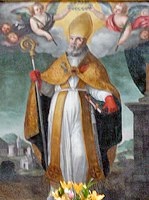
St Fulgentius (17th century, in Santa Maria Assunta)
with the churches of San Vittore and San Fulgenzio (see below) in the background
The walk so far (from San Fulgenzio to San Vittore) took you through what was probably the heart of Christian Ocriculum, at least in the 6th and 7th centuries. The date of formation of the diocese of Ocriculum is unknown, but four early bishops are recorded:
-
✴Bishop Herculeus, who attended the synod in Rome in 487;
-
✴Bishop Constantinus, who attended the synod in Rome in 499;
-
✴Bishop (later St) Fulgentius, who is recorded in the Dialogues of Pope Gregory I, in an account of how he saved Ocriculum from Totila, presumably in ca. 543 (see below); and
-
✴Bishop Domenico, who attended synods held in Rome by Gregory I in 595 and 601.
An inscription (6th century) found in località Civitelle (mentioned above and discussed further below) might record an otherwise undocumented fifth bishop, Marcellus. The diocese was subsequently absorbed into that of Narni, possibly when the settlement by the Tiber was abandoned.
San Vittore (18th century)
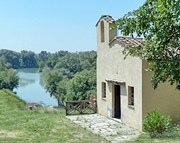
The most important evidence of an early church here is in the form of three inscriptions that are now in Santa Maria Assunta:

The most important of these, which surrounds a relief of a Cross and two lambs, records that St Fulgentius discovered the relics of the 2nd century martyr St Victor and erected an altar over his grave:
IVBANTE DEO FVLGENTIVS EPISCOPVS INVENTO CORPORE
MARTYRIS VICTORIS IN XR(IST)I NOMINE SVPER ALTARE CONSTRVXIT
It is usually assumed that St Fulgentius subsequently built the first church of San Vittore on the site, presumably in the middle of the 6th century. The relics and the inscription (which might well have come from the edge of the original altar erected by St Fulgentius) were translated to Santa Maria Assunta in 1351.

The second inscription relates to the relics of St Fulgentius himself:
Hic requiescunt S(an)cti Fulgentius
Lozimus Nectarius Leopardus et Corona
martyres C(h)r(ist)i
This inscription, which is probably slightly later than the one above, is set out in a single line on what was probably an architrave. Its original location is unknown, but it was probably in San Vittore, and presumably accompanied the relics of these saints when they were translated from San Vittore to Santa Maria Assunta in 1316. We might reasonably assume therefore that the inscribed architrave originally belonged to the portal of the room in San Vittore (presumably a crypt) that had housed the relics. (These translated relics were presumed to have included some of St Corona, although at least some of them had apparently/allegedly been taken to Aachen in ca. 1000 by Otto IIII).
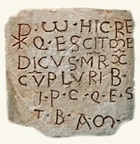
HIC REU(VI)ESCIT MEDICUS M(A)R(TIR) X(RISTI)
CV(M) PLVRIB(VS) I(N) P(A)C(E) QVIES(CEN)TIB(VS) AM(EN)
Gianfranco Binazzi (referenced below, at pp. 3-4) described the results of these excavations (which had been published by Marco Antonio Boldetti in 1720):
-
“... under the tribune of San Vittore was found in fact a travertine sarcophagus containing some bones and an inscription that recorded the burial of St Medicus and other martyrs of Otricoli. ... [soon after], other burial sites were found nearby, excavated out of the tufa and closed by tiles. Furthermore, a staircase cut out of the rock led to a subterranean grotto under the tribune of the church, its walls decorated with red and black crosses that had 57 burial niches below, again closed with tiles” (my translation).
Unfortunately, nothing now remains of these burial sites, and Benazzi drew attention to the possible unreliability of the published description of them. However, he concluded that:
-
“... what emerges clearly is that this was a funerary gallery [catacomb], which is unusual in Umbria, found at only one other place, Villa San Faustino, Massa Martana” (my translation).
The relics and inscription were translated to Santa Maria Assunta in 1612 and placed in the crypt there in the following year.
Luciano Bassotti (referenced below, at pp. 81-6) has given a full account of the subsequent history of the complex. The first record of a church here dates to 1227, when the abbot of the adjacent Benedictine abbey appealed to Pope Honorius III against its planned transfer to the jurisdiction of the Bishop of Narni. This appeal apparently failed, since Pope Gregory IX duly assigned the abbey to the Bishop of Narni in 1233. In any case, this monastic complex seems to have been destroyed by flooding later in the century.
The church was listed among those of Narni in 1381. It was close to collapse at the time of an apostolic visit in 1571 but restored later in the decade. The discovery of the relics of St Medicus in 1611 (above) prompted further complaints about its poor state of repair, followed by another restoration. It was finally deconsecrated in 171o and presumably demolished at some time thereafter.
The defunct abbey must have continued to generate an income, since it had a series of commendary abbots from the mid 17th century, one of whom was Cardinal Panfili, the future Pope Innocent X. Another, Cardinal Carlo Bichi, built the current church, which was consecrated on the 18th April 1714. A third, Cardinal Alessandro Albani (1721- 79) introduced the cult of the Madonna del Buon Consiglio to San Vittore, but transferred it to San Fulgenzio (below) in 1756.
The marble cornice above the entrance to the church has been dated to the 1st century AD. Three inscribed fragments (CIL XI 4093 a and b; and CIL XI 4099) from the complex were recognised in 2008 as belonging to a single inscription and associated with the Roman mausoleum (below): they reveal that this mausoleum belonged to Lucius Cominus Tuscus, son of Caius, of the Arnensis tribe. (Luana Cenciaioli, referenced below, 2012, at pp. 31-2, who did the detective work, published photographs of the three fragments in situ).
San Fulgenzio [Date ??]
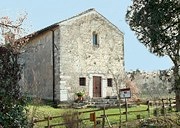
According to Martin Millett (in the book by S. Hay et al., referenced below, at p. 11):
-
“The origins of [San Fulgenzio] are uncertain, although structural remains within its standing walls have been taken to suggest an early Christian origin.”
Luciano Bassotti (referenced below), the source of most of what follows, observed (at p. 88) that the structure:
-
“... incorporates part of an early Christian structure, traces of which are recognisable in the wall towards the street, where the arches of three contiguous windows and a ‘controarco’ above a door are clearly legible” (my translation).
It is certainly unlikely that a church dedicated to St Fulgentius was established here after the adjacent urban settlement was abandoned in the 7th century. Nevertheless, as Bassotti pointed out, despite frequent (albeit tentative) suggestions that this putative early church once housed the relics of St Fulgentius, there is no surviving evidence to this effect.
In fact, the earliest surviving document relating to San Fulgenzio describes an apostolic visit by Pietro Lunel, Bishop of Gaeta, in 1571. As noted above, Cardinal Alessandro Albani (1721- 79) transferred the cult of the Madonna del Buon Consiglio from San Vittore to San Fulgenzio in 1756. The earliest document in which the church is given this (its present) dedication relates to an apostolic visit in 1787.
The church subsequently fell into disuse, but was reopened for cult purposes in the 1960s and now provides the premises of the Confraternita della Madonna del Buon Consiglio.
Paleochristian Site in località Civitelle (?)
Gianfranco Binazzi (referenced below, at pp. 8-10) described two inscriptions that were found in 1938 in località Civitelle (tentatively indicated in the plan above as a forum) both of which are now in the Museo Archeologico Nazionale delle Marche:
-
✴One inscription (ca. 600) reads
-
huc(!) propera festine sacram cognoscere legem ...
-
aulam qu[a constat?] purgari facta liquore ...
-
inmersumq(ue) sacris renovatum exsurgere corpus ...
-
pa[...] locum ...
-
ad postquam incipiens meruit tua tecta sacerdos ...
-
luxq(ue) fulg[...]
-
haec Marcellus ovans linfis(!) haec facta dicavit ...
-
longoque miran[s ...] ...
-
The surviving fragment, which is of the left part of an architrave, preserves part of a poem made up of eight hexameters. According to Gianfranco Binazzi (referenced below, at p. 9):
-
“Notwithstanding the lacunae in the text, it seems evident that it refers to a baptistery ... ; ‘sacerdos’ could stand for ‘episcopus loci’, and thus Marcellus, the person who dedicated the baptistery, could be an otherwise undocumented local bishop” (my translation).
-
✴The second inscription (probably 6th century), probably from an altar, reads:
-
de donis d(e)i Mercurius cum suis t...
Binazzi also described (at p. 6) a bronze Christogram (probably 5th century) that had been found in 1926 at the same location, which is now in the Museo Cristiano, Biblioteca Vaticana. These finds suggest that there was a paleochristian centre here in late antiquity.
Pre-Christian Ocriculum
Pre-Roman Settlement
Retrace your steps along the path that brought you to San Vittore and stop at the cross before the ‘Forum’: as shown in the plan above, the path to the left leads to the site of the so-called Porto d’ Olio, which was originally on a meander of the Tiber. All trace of it was lost after the river changed course. The first settlement on this site occurred on the ridge between the original meander and the path that you have just walked along. Martin Millett (in the book by S. Hay et al., referenced below, at pp. 141-3) summarised the results of the recent excavations here:
-
“Our survey has added significantly to knowledge of [the pre-Roman settlement of the ridge] by identifying what is probably an earthen rampart defining the northern [i.e. the riverine] side of the [settled area]. Although this feature remains undated, there must be a strong possibility that it relates to the pre-Roman phase ... If it is of this period, this would suggest that the settlement was rather more extensive than previously thought, covering the whole of the ridge to the west of the modern crossroad. The pattern of its growth from the [previously identified] 8th century BC nucleus [at the western end of the ridge] is uncertain, but its position commanding an important landing place on a bend in the Tiber ... is surely significant. Ceramic evidence from ... the centre of the [ridge] ... certainly indicates continuous occupation from the first half of the 3rd century BC, with the possibility of some activity in the [previous] century. This shows that the core of the settlement on the ridge had [already] expanded before the alliance with Rome in 308 BC and certainly much before the construction of Via Flaminia in 220 BC. Given the uncertainty about the date and status of the [walled settlement on the later site of modern Otricoli], it is not possible at present to establish whether the two sites were occupied consecutively or contemporaneously ... However, the chronology provided here shows that, by the time that Via Flaminia was constructed, there was an important settlement here that was on its planned route, which may have been designed to pass in front of the entrance to the historic core.”
This dating for the occupation of the ridge undermines the ‘received wisdom’ that the hilltop site was destroyed in the Social Wars (ca. 90 BC), and that it was only at this point and for this reason that the Ocriculani moved to the site by the Tiber.
Roman Ocriculum
The epigraphic evidence suggests that there was a thriving municipium here after the Social Wars. Martin Millett (in the book by S. Hay et al., referenced below, at p. 146) suggested that the first phase of its monumentalisation (perhaps including the ‘substructures’ and its temple and the theatre, all discussed below) might have been associated with Augustus’s restoration of Via Flaminia in 27 BC.
Augusteum (1st century AD ?)
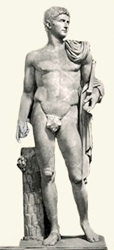
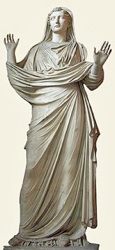

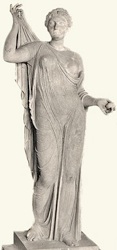
Augustus Orant women/ Livia Caligula/ Claudius Drusilla/ Venus
Musei Vaticani:
Sala a Croce Greca Sala Busti Sala Rotunda Gabinetto delle Maschere
Sophie Hay et al. (referenced below, at pp. 51-4) described the results of their recent excavation of the fenced area around an agricultural building that is immediately on your right as you turn right at the crossroads. They reported that:
-
“... it was clear from [our] topographic survey that a podium of about 1 meter in height occupied this area. It extended for about 40 meters [along the road that you are now walking along] from the corner of the field by the crossroads ...”
Their associated Figure 3:22 superimposed:
-
✴the plan of a ‘basilica’, which had been made by Giuseppe Pannini during the excavations of the 18th century (also illustrated as Figure 2:4); and
-
✴the remains of an apse that they had uncovered, about midway between the crossroads and the agricultural building. [Are these remains still visible ??]
The fit was good, and they therefore proposed that ‘their’ apse fixed the previously uncertain location and orientation of Pannini’s ‘basilica’.
Gianna Dareggi (referenced below) had already argued this ‘basilica’ was in fact an Augusteum (a building devoted to the imperial cult), on account of: its architectural plan; its apparently impressive decoration; and the fact that it contained a number of early imperial statues (below). Margaret Laird (referenced below, at pp. 78-84) cautioned against an implication that has been drawn from Dareggi’s work: that this was necessarily the premises of a college of Augustales, and that its members would necessarily have commissioned its statues. As she pointed out, it could equally have served as a municipal temple.
Martin Millett (in the book by S. Hay et al., referenced below, at p. 21, Table 2:1) listed six statues recorded in the Vatican archives relating to the 18th century excavations, all of which had apparently been found in the ‘basilica’. All six of these statues are now in the Musei Vaticani. They include:
-
✴the four illustrated above:
-
•a standing figure of the nude Augustus as Diomedes:
-
Diomedes, King of Argos is identified in Homer's ‘Iliad’ as the warrior who stole an iconic statue of Athena/Minerva known as the Palladium from Troy in order to remove that city’s invulnerability to attack. The icon, which was said to have been brought to Italy at the time of Aeneas, was preserved in Rome under the auspices of the Vestals. The canonical figure (ca. 430 BC) of Diomedes, which is attributed to the Greek sculptor Kresilas, is known from a Roman copy in the Glyptothek, Munich: scholars think that Kresilas depicted him here with the stolen statue in his left hand. Augustus was one of a series of emperors who were depicted as Diomedes (which notably also included Hadrian, who is so-represented in at least four surviving statues): perhaps this implied the claim that, by protecting the Vestals and the holy objects in their custody, these emperors ensured the invulnerability of Rome.
-
•a praying woman, usually identified as Livia:
-
Anthony Barrett (referenced below, at p. 161), for example, suggested that Livia was depicted here in her capacity (from 14 AD) of “wife and priestess” of the dead and deified Augustus, before her own deification (in 42 AD);
-
•a colossal head of Caligula, recut to represent Claudius (discussed below); and
-
•a figure of Venus:
-
Susan Wood (referenced below, at p. 244) and Eric Varner (below) identified her as Venus Genetrix (note the egg in her left hand), the alleged founder of the Julio-Claudian dynasty, and suggested that the original head had been replaced by that of Julia Drusilla, the sister and nominated heir of Caligula, who died unexpectedly and was deified in 38 AD; and
-
✴two togate figures identified as Julio-Claudian princes:
-
•one in the Sala a Croce (S. Hay et al., referenced below, Figure 2:11), in which the figure is veiled and sacrificing; and
-
•another, of a younger man, in the Galleria dei Candelabri (S. Hay et al., referenced below, Figure 2:12).
According to Eric Varner (referenced below, at p. 28, following Gianna Dareggi, referenced below, whose paper that I have not yet managed to access), the bust of Caligula/ Claudius:
-
“... occupied the central apse [of the Augusteum]. [It came from] a seated statue, probably depicting [Caligula] in the guise of Jupiter Optimus Maximus Capitolinus, and indeed fragments of a seated figure... are noted in early accounts of the excavations. [This statue], together with a representation of Drusilla as Venus Genetrix, was added to a cycle of Julio-Claudian statuary [comprising the other four figures in the list above, which had probably been] commissioned early in the reign of Tiberius ....”
This bust would have been recut after the murder of the hated Caligula in 41 AD and the acclamation of his uncle, Claudius. Eric Varner (referenced below, at p. 28) suggested that:
-
“The colossal scale of the Caligula indicates that it was [retrospectively inserted] as the focal point of this dynastic group, whose other statues are essentially life-sized or slightly over. ... the specificity of the [original bust of Caligula] to its ancient site, its importance as the centrepiece of the statuary cycle, and its association with the imperial cult ... [would have] dictated [its] reconfiguration [as Claudius], rather than its removal or disfigurement.”
If Eric Varner is correct in dating the four earliest statues in the cycle to the early part of the reign of Tberius (14 - 37 AD) we can reasonably assume that the Augusteum had been built by that time. Note, however, that some scholars date all six statues to Caligula’s reign (37 - 41 AD).
[One wonders whether the inscription (ca. 42 BC) from the base of a statue of divus Julius found at Ocriculum (described in the page on the History of Otricoli. )implies an earlier Caesareum , albeit no necessarily on this site.]
[Link to the Augusteum at Carsulae]
Augustan/ Early Imperial Forum ?
Martin Millett (in the book by S. Hay et al., referenced below, a at p. 147) described a rectangular terrace of some 230 x 70 m that spread across the road on which you are walking (see Figure 6.6, a schematic of the suggested topography of Ocriculum in the early Empire, in which this area is shaded and labelled as a ‘forum ?’). It extended from a point to south of the agricultural building to the rear terrace of the substructures in front of you (see below). They suggested that the eastern edge of the terrace was defined by Via Flaminia (which, in the team’s reconstruction, met the road on which you are walking from the east - your left - at the point just beyond the substructures, before diverging again to your left), and that it extended to the west along the back of the theatre (below). Mallett commented that this terrace:
-
“... may have formed a monumental focus for the town. This perhaps can be labelled as a forum, [albeit that] it is remarkably large and was occupied by a series of structures. Immediately to its north lay the surviving remains interpreted as the ‘basilica’ or Augusteum [above], supporting the suggestion that it was a forum. Its size and position in relation to the Via Flaminia are comparable with the Augustan layout, incorporating the theatre, at Carsulae.”
Substructures (1st century BC)
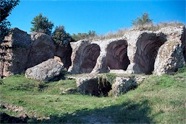
-
“... it is arguable that [its components] were constructed in several phases, and that [the resulting structure is] best interpreted as a platform that supported a temenos [enclosed sacred area] with a temple at its centre ...”
He pointed out that the putative temple would certainly have dominated the skyline as visitors approached the municipium by Via Flaminia or by river. He also noted that this temple has been associated with at least two finds from the site:
-
✴The famous head of Jupiter in the Musei Vaticani (see below) might have come from a Capitolium here.
-
✴An inscription (CIL XI 4082) that refers to temple to Valentia, who was a goddess of health or well-being. Tertullian, writing in 197 AD, recorded that she was revered in Ocriculum but not in Rome (‘Apologeticus pro Christianis’, 24:8). The inscription, which dates to the 3rd century AD, reads:
-
Pro salute itus ac/ reditus d(omini) n(ostri) sanctis/simi [... Invic]/ti Aug(usti)
-
aediculam/ concili(i) deorum/ dearumque/ Aurelius Faustus
-
prot(ector) divini lateris/ Aug(usti) n(ostri) ex viso deae / Valentiae
-
s(ua) p(ecunia) f(aciendum) c(uravit)
-
Thus, a soldier called Aurelius Faustus, who was a member of the imperial bodyguard (protector divini lateris Augusti nostri), built a sanctuary to Valentia somewhere in Ocriculum for the health of an emperor whose name is no longer legible.
However, as Martin Millet pointed out:
-
“In the absence of good evidence for the find spots [of both the statue of Jupiter and the inscription relating to Valentia], neither suggestion can be confirmed”.
Theatre (late 1st century BC/ early 1st century AD)
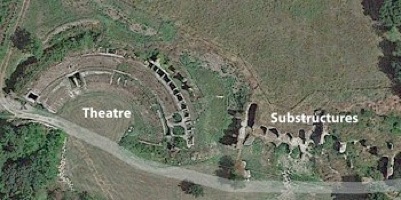
A surviving inscription (CIL XI 7806) reads:
...o L(uci) f(ilio) Ataedio quinq(uennali) [...]
[... ]ere conlat(o) ludis dedication(e) sca[enae)
Ataedius, the quattuorvir quinquennalis, had thus financed games to celebrate the dedication of a scaenae, presumably that of the theatre that was excavated in the late 18th century. He is almost certainly Passenius Ataedius, who is recorded in two other inscriptions (CIL XI, 7807-08) from the site. It is usually assumed that he had financed at least part, if not all, of the theatre. Frank Sear (referenced below, at pp. 161-2) dated the inscription and the theatre itself to the Augustan period (27 BC - 14 AD).
Most of the surviving structure is in opus reticolatum and was originally faced in marble. The entrance is built of blocks of tufa. Frank Sear (referenced below, at pp. 161-2) recorded the diameter of the well-preserved cavea at 79 meters. A number of terracotta antefixes found here during excavations carried out in 1962 are now in the Antiquarium Casale San Fulgenzio.
Two statues of headless seated muses in the Sala a Croce Greca, Musei Vaticani, which apparently date to the reign of Antoninus Pius (138-61 AD), might have come from the theatre [reference and quote to follow].
Baths (2nd century AD?)
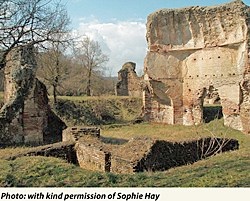
The original construction of the baths is recorded in an inscription (CIL XI 4090, Galleria Lapidaria, Musei Vatican) found nearby:
Iuliae Luciliae / L(uci) Iuli Iuliani fil(iae) / patroni municipi(i)
cuius pater/ thermas Ocricola/nis a solo extructas / sua pecunia dona/vit /
decur(ionum) Aug(ustales) plebs / l(ocus) d(atus) d(ecreto)
This records that the decurians, Augustales and people of Ocriculum dedicated a statue of Julia Lucilia, whose father Julius Julianus had financed the construction of thermal complex and given it to the city. (For more on Julius Julianus, see the page on the History of Otricoli.)
An inscription (CIL XIV 98) in the Galleria Lapidaria, Musei Vaticani, records that the Emperor Antoninus Pius had completed (in 139 AD and at considerable expense) a thermal complex that had been begun by the Emperor Hadrian. Carlo Pietrangeli [reference and quote to follow] suggested that this inscription came from Ocriculum.
-
✴Garrett Fagan (referenced below, at p. 234) has pointed out that this putative imperial patronage seems to be inconsistent with the role of Julius Julianus, but it seems to me that the summer and winter baths (below) could possibly have been separate projects.
-
✴[Martin Mallett (in the book by S. Hay et al., referenced below, at p. 20 includes a statue of Antoninus among a number of imperial statues found at Ocriculum, and this might conceivably have come from the thermal complex.]
This impressive thermal complex, which was fed by the underground Rio San Vittore, stands on a terrace that was built as part of a project involved the diversion of the stream into an underground canal some 300 m long and the infilling of a substantial section of the surrounding valley. According to Martin Mallett (in the book by S. Hay et al., referenced below, at p. 149):
-
“The project clearly involved sophisticated and large-scale engineering work that seems also to have provided a system of cisterns fed by forcing water up from the river as it flowed though a deeply-buried conduit by shutting off the exit.”
-
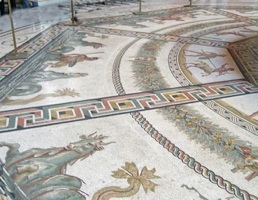
-
Mosaic: Sala Rotunda, Musei Vaticani
-
✴The ‘octagonal room’ of the summer baths is still clearly visible. Hay et al. (referenced below, at p. 59, citing Luana Cenciaioli) reported that a brick stamp dated ca. 145-50 AD was found in situ in its superstructure. Its polychrome mosaic floor (4th century AD ?? - date to be confirmed) is now on the floor of the Sala Rotunda, Musei Vaticani. The scenes depict the battle of the Greeks and the centaurs.
-
✴The remains of the winter baths (which probably stood slightly further to the north) are no longer visible. However, a number of inscriptions from this location document their restoration in the 4th century:
-
•An inscription (CIL XI 4095) records that Sextus Cluvius Martinus and Marcus Caesolius Saturninus repaired them in the “challenged age” of the Emperors Constantius II and Constans. The reference here is to the civil war of 340 AD, in which Constans defeated his other brother, Constantius II. The inscription itself is dated to the consulship of Antonius Marcellinus and Petronius Probinus (341 AD).
-
•Three statue bases from the area also relate to the restoration of the winter baths:
-
-The people and local council ‘splendidissimae civitatis Ocricolanae’ (of the most splendid city of Ocriculum) set up marble statues to the two men mentioned in the above inscription, as evidenced by the surviving statue bases in the Galleria Lapidaria, Musei Vaticani. Their respective inscriptions commemorate:
-
‣Sextus Cluvius Martinus (CIL XI 4096; LSA-1632); and
-
‣Marcus Caesolius Saturninus (CIL XI 4097; LSA-1633).
-
-The inscription on the third base (CIL XI 4094; LSA-2682; Museo Pio Clementino, Musei Vaticani) commemorates Caius Volusius Victor, who similarly restored the winter baths and received a statue. Unfortunately, this inscription (and hence the date of the corresponding restoration) can only be roughly dated to the 4th century AD.
Nymphaeum (early 1st century AD)
The nymphaeum, slightly northeast of the baths, was also fed by the Rio San Vittore. This long substructure of 50 m is characterised by an elegant wall in opus reticulatum that contained three public fountains within its alternating semicircular and rectangular niches. It is connected through a system of still functional subterranean tunnels to the cistern now visible inside the Antiquarium Casale San Fulgenzio.
Mausoleum (1st century BC)
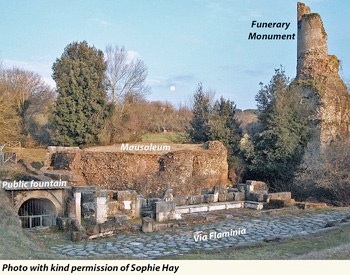
This drum-type funerary monument, which was excavated in 2008, dates to the early Augustan period (ca. 27 BC). The drum, which stands on a square base, is made of cement and was faced with ashlar. The few surviving facing blocks have been returned to their original locations. Three fragments of an inscription (CIL XI 4093 a and b; and CIL XI 4099) found in San Vittore (above) were recognised in 2008 as belonging to a single inscription and associated with the mausoleum: they reveal that it belonged to Lucius Cominus Tuscus, son of Caius, of the Arnensis tribe. (The relevant excavations were carried out by Luana Cenciaioli and summarised by her in English in the book by S. Hay et al., referenced below, at p. xii-xiii.)
[Remains of a bone funerary bed, now in the Antiquarium Casale San Fulgenzio]
The public fountain next to the mausoleum (to the left in the photograph above), like the nearby nymphaeum (above), was fed by the Rio San Vittore.
A stretch of Via Flaminia some 6 meters wide and 25 meters long was excavated in 1992-4 in front to the mausoleum. It is built with large leucite paving stones from quarries at nearby Borghetto. The road shows signs of wear from carts and has been repaired with white limestone paving materials.
Amphitheatre (1st century AD)
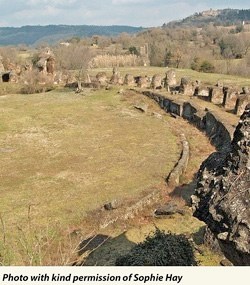
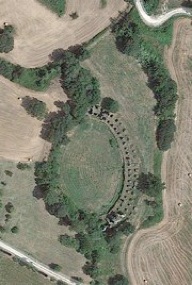
This structure, which was excavated in 1958, was partly cut into the surrounding rock on a site to the west of Via Flaminia and to the south of the city. Its external walls have been destroyed, but the surviving parts of the structure include:
-
✴the vaulted intermediate gallery of the cavea;
-
✴the remains of the two main entrances;
-
✴the floor of the arena, which, according to S. Hay et al. (referenced below, at p. 31), measured ca. 63 x 40 meters along its axes,; and
-
✴part of the podium.
The western half of the amphitheatre, which was the part that was cut into the rock, is now heavily overgrown. According to S. Hay et al. (referenced below, at p. 34), the structure can probably be dated to the first half of the 1st century AD.
Continue south towards the second entrance to the archeological area (marked by the red arrow at the lower right of the plan), from which you can return to Otricoli (turn left and immediately right along Via Roma).
Art from Ocriculum
Some of the finds from the excavations (1776-84) organised by Pope Pius VI are now exhibited in the the Pio-Clementine Museum of the Musei Vaticani, Rome. These include the octagonal mosaic from the baths, illustrated above.
Jupiter of Ocriculum (1st century AD)

This head must originally have formed part of a huge statue of the seated Jupiter. It was probably based on the similar statue that Apollonius of Athens made for the Capitoline Temple, Rome after the fire of 83 BC, which in turn was probably a copy of an ancient statue of Zeus at Olympia (see, for example, Filippo Coarelli, referenced below, at p. 34).
The original location of the statue at Ocriculum is uncertain, but it might well have come from a Capitolium (a tripartite temple to Jupiter, Juno and Minerva) on the terrace above the so-called substructures (above).
Read more:
M. Laird, “Civic Monuments and the Augustales in Roman Italy”, (2015) Cambridge
S. Hay, S. Keay and M. Millett, “Ocriculum (Otricoli, Umbria): An Archaeological Monograph (number 22) of the British School at Rome”, (2013)
M. Rossi Caponeri and E. David (Eds), “Il Tevere a Otricoli: Vita e Fede sulle Rive del Fiume”, (2012) Viterbo, includes:
L. Cenciaoli, “Il Tevere a Otricoli: Gli Aspetti Archeologici”, pp. 21-32;
L. Bassotti:
-“La Chiesa e l' Abbazia di San Vittore”, pp. 81-5: and
-“La Chiesa della Madonna del Buon Consiglio in San Fulgenzio”, pp. 87-90
F. Coarelli, translation into English of a number of his works on the topography of ancient Rome, as:
J. Clauss and D. Harman, “Rome and Environs: An Archaeological Guide”, (2007, 2nd edition 2014) Oakland, California
L. Cenciaioli (Ed.), “Un Museo per Otricoli : l' Antiquarium Casale San Fulgenzio”, (2006) Perugia
F. Sear, “Roman Theatres: An Architectural Study”, (2006) Oxford
E. Varner, “Mutilation and Transformation: Damnatio Memoriae and Roman Imperial Portraiture“ (20o4) Leiden
A. Barrett, “Livia: First Lady of Imperial Rome”, (2002) Yale
G. Fagan “Bathing in Public in the Roman World”, (2002) Ann Arbor, Michigan
S. Wood, “Imperial Women: A Study in Public Images, 40 BC - 68 AD”, (1999, 2nd edition 2000) Leiden
G. Binazzi, “Inscriptiones Christianae Italiae: Regio VI; Umbria”, (1989) Bari
G. Dareggi, “Il Ciclo Statuario della ‘Basilica’ di Otricoli: la Fase Giulio–Claudia”, Bollettino d‘ Arte, 14 (April-June 1982) pp 1-36
The following websites provide more details of the Roman monuments at Ocriculum:
•an interesting website by Sophie Hay (see reference above): “Unravelling the Roman town of Ocriculum (Otricoli) and a bit more besides”.
Return to the page on Walks in Otricoli.

